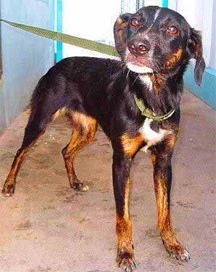Laryngitis Continued

Symptoms
Usually, the first sign of laryngitis is a lush, dry, short cough. Later on, the cough is associated with a liquid build-up and we hear a softer and moist cough. This phase is often accompanied with pain. The dog actually shows signs of discomfort when the coughing episode begins. The coughing spasm is exaggerated when the pressure is placed on the larynx, or if the animal swallows large morsels of cold food or cold water.

Changes in the way the dog barks (the sound) are noticeable. Bad breath and difficult, noisy breathing are usually evident.
As the ailment progresses, the dog may stand with its head down and with its mouth open trying to ease the pressure (and pain) on the larynx. In some cases, the body temperature increases to as much as 105°F (40-41°C).
An increase of water fluid (oedema, dropsy) in the tissue of the larynx develops early, and this results in an increased rate of breathing (the dog is making a real effort to breathe). Because there is not enough air being inhaled, the tissues become starved of oxygen, and carbon dioxide accumulates causing the tissue in the mouth and tongue to take on a blue pallor (cyanosis). The pulse rate is racing as the heart tries to compensate for the lack of oxygen. At this point, the ailment has been allowed to progress too far without treatment, and the situation is critical.
Treatment
Before the condition becomes critical, the animal should be visiting the vet. At the onset, the vet would introduce medication which would reduce the inflammatory swelling. Antibiotics could be administered at this stage, especially if there is a fever. I tend to prescribe diuretic drugs to get rid of the increase in fluid in and around the larynx.
If there is laryngeal obstruction, only your vet can intervene, possibly with the help of a special tracheotomy tube.
While all this medication is being administered, one should offer the animal some supportive therapy, which would include soft (liquid) food and a clean, dust-free environment. Painkillers (analgesics) are indicated to combat the discomfort. One can go so far as to ensure that the dog inhales humidified air – the same methodology (covering the head with a towel and inhaling steam emanating from a basin) as we humans use to treat the same condition.
Synopsis
The identification and treatment of the primary problem must be carried out as soon as possible. Below, in telegram style, are some palliative, preventative and curative procedures which can be introduced to counter this ailment:
*Inhalation of humidified air (see above)
*Confinement in a warm, clean, draft-free environment
*Feeding soft or liquid foods
*Avoiding dusty living conditions
*Introducing, under veterinary advice and supervision, antibiotics and sulfonamides to control bacterial infections in the laryngeal (larynx) area
*Suppressing the cough with antitussive preparations (commercial cough suppressants which are on the market for human use)
*Controlling pain with judicious use of an analgesic (anti-pain medication) – especially in cats.
*Tracheotomy (preformed by your vet) may be necessary if obstruction of the larynx is severe enough to cause respiratory distress (difficult breathing) leading to an oxygen intake deficiency (cyanosis)
All of the above can promote recovery and give comfort to the animal.
Please implement disease preventative measures (vaccinations, routine dewormings, monthly anti-heartworm medication, etc) and adopt-a-pet from the GSPCA’s Animal Clinic and Shelter at Robb Street and Orange Walk, if you have the wherewithal to care well for the animals. Do not stray your unwanted pets, take them to the GSPCA’s Clinic and Shelter instead. If you do not wish your pet to have puppies or kittens, you may exploit the GSPCA’s free spay and neutering programme. If you see anyone being cruel to an animal, or if you need any technical information, please get in touch with the Clinic and Shelter by calling 226-4237




